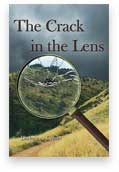Full review of The Crack in the Lens by Darlene Cypser
 Darlene Cypser has pulled off an amazing conjuring trick with The Crack in the Lens, writing an original Sherlock Holmes story that is in no way a Sherlock Holmes story and that owes more to Emily Brontë than Arthur Conan Doyle.
Darlene Cypser has pulled off an amazing conjuring trick with The Crack in the Lens, writing an original Sherlock Holmes story that is in no way a Sherlock Holmes story and that owes more to Emily Brontë than Arthur Conan Doyle.
Cypser’s novel introduces us to 17-year-old Sherlock, happy to have returned to his Yorkshire home. He is the youngest son of the forbidding squire, Siger Holmes, with older brothers Mycroft and Sherrinford. His father considered him a delicate child who suffered from pneumonia growing up and has little faith in the young man he is about to be. Siger Holmes hopes his son will enter university and train to be an engineer, a suitable profession for a youngest son who would not inherit the family estate. And to that end Siger Holmes has engaged a professor of mathematics who will tutor — and torture — the boy.
But at first young Sherlock is simply happy to be home and free to roam the moors. Of course it’s on the moors that he meets Violet Rushdale, daughter of one of his father’s tenant farmers. It’s a star-crossed match: the squire’s son and the daughter of a tenant who’s fallen to drink and is behind in the rent after the death of his wife. And of course being star crossed, the attraction is irresistable and one day after Sherlock and Violet slip and fall in freezing water and seek shelter in a prehistoric hut and … well, as I said, The Crack in the Lens is more Brontë than Doyle and young Sherlock is not the misogynist of Watson’s years.
One of the most amazing parts of Cypser’s conjuring trick is that it’s so simple. Boy meets girl, boy is denied girl through the machinations of his tutor, girl denies boy thinking it best for him and ultimately boy loses girl, which I don’t think is a spoiler because every woman reader who has ever felt for him knows he had a tragic past. If I can offer any criticism, it’s that Sherlock must prove himself impossibly obtuse when confronted by Violet’s denial. It’s like those times Watson is confronted by Holmes in disguise and you can’t believe the good doctor can be so easily fooled. But the misapprehension is important to the story and after all, young Sherlock is only seventeen, not wise in matters of love and also suffering under the slanders his tutor has laid before Siger Holmes.
Cypser’s restraint is also admirable in not making too many winking nods to Sherlock’s future as the great detective, with few in jokes I noticed other than a plausible relation to another great Doyle creation and many foreshadowings to Holmes’ skill at boxing and fencing and his affinity with the working classes and children. I’m sure there are other Holmesian nods that Cypser has added that I have missed in my Watsonian clumsiness, but I think they are subtle.
Cypser has also created one of the great sick bed scenes of all times, rivaling anything from Austen, Brontë or Dumas and her forging of the detective Holmes from the crucible of young Sherlock’s despair makes The Crack in the Lens has made a lasting impression on me.
